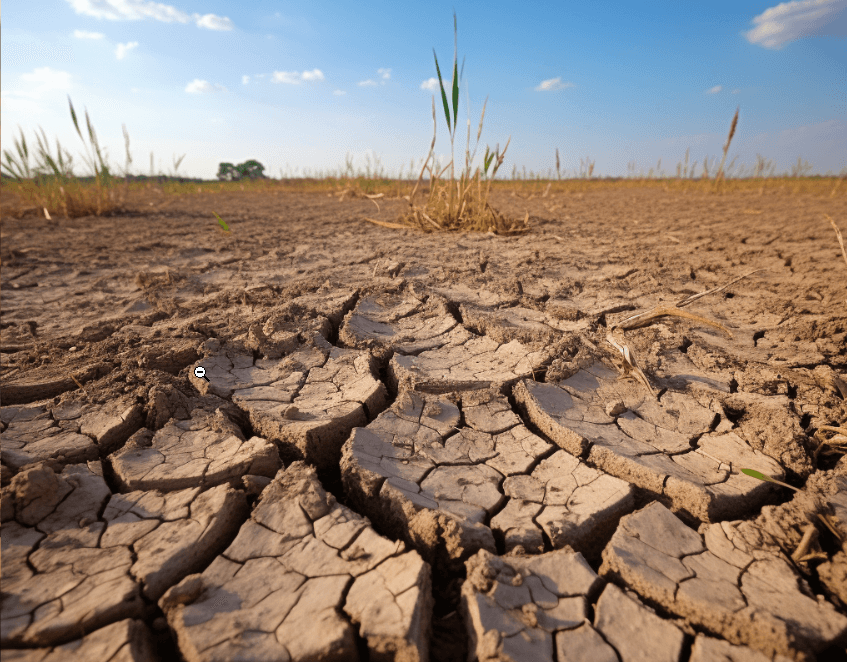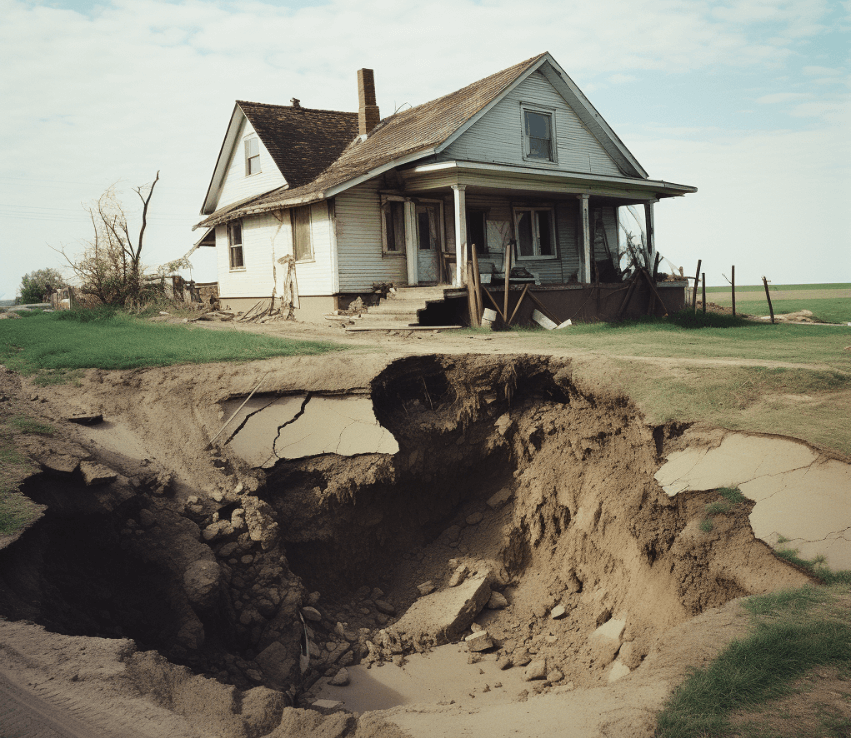What are Expansive Soils and What Problems Can They Cause?
Soils are an essential component of the Earth’s crust, and they play a crucial role in supporting the foundations of our built environment. However, not all soils are the same. Some soils, known as expansive soils, can pose significant challenges during construction and cause long-term problems.
Expansive soils are characterized by their ability to swell and shrink depending on the moisture content. When these soils absorb water, they expand, and when they dry out, they contract. This constant movement can put stress on structures built on top of them and lead to various problems.
One of the most common problems associated with expansive soils is erosion. The expansion and contraction of the soil create cycles of pressure on the surrounding area, which can lead to the erosion of the soil and the destabilization of the foundation. This erosion can be particularly problematic for structures built on hillsides or near bodies of water.
Another significant issue caused by expansive soils is the formation of cracks in the ground. As the soil expands, it can exert tremendous pressure on the foundations, resulting in cracks. These cracks can impact the stability of structures and lead to costly repairs. Additionally, the cracks created by the expansive soil can provide a pathway for water infiltration, exacerbating the erosion problem.
Understanding the behavior of expansive soils and their potential problems is crucial for construction projects. Building on expansive soils requires careful planning and engineering to mitigate the risks. Measures such as proper grading, foundation design, and moisture control can help minimize the effects of expansive soils and ensure the long-term stability of the structures.
What are Expansive Soils?
Expansive soils are a type of soil that have the ability to expand when they come into contact with moisture. These soils are known for their high clay content, which makes them prone to swelling and shrinking with changes in moisture levels.
When expansive soils come into contact with moisture, they absorb the water and swell in volume. This expansion can cause significant problems for construction projects and property owners.
One of the main problems caused by expansive soils is the formation of cracks. As the soil expands, it puts pressure on the foundation and structures above it. This pressure can lead to the development of cracks in the foundation, walls, and other parts of the building.
In addition to cracks, expansive soils can also cause erosion. When the soil swells and creates pressure, it can push against other soil and rock layers, causing them to erode or shift. This erosion can weaken the stability of the ground and structures built on top of it.
Expansive soils can pose a significant risk to construction projects and structures. It is important to identify and address the presence of expansive soils during the planning and design stages of a project to prevent potential problems in the future.
Characteristics of Expansive Soils:
-
- High clay content
- Ability to absorb and retain moisture
- Proneness to swelling and shrinking
- Potential to cause cracks and erosion
Effects of Expansive Soils:
-
- Formation of cracks in foundations and structures
- Erosion and shifting of soil and rock layers
- Weakening of ground stability
- Potential damage to buildings and infrastructure
Overall, expansive soils are a common geological problem that can cause significant damage to construction projects and property. Understanding their characteristics and effects is crucial for mitigating potential problems and ensuring the long-term stability of structures.
Definition and Explanation
Expansive soils, also known as shrink-swell soils, are a type of soil that undergo significant changes in volume due to changes in moisture content. These soils have the ability to expand when wet and shrink when dry, which can cause serious problems for construction projects and property owners.
The main cause of the expansive soil behavior is the presence of clay minerals that are capable of absorbing and retaining large amounts of water. When the soil becomes saturated, it swells and increases in volume. On the other hand, when the soil loses moisture, it shrinks and decreases in volume.
These changes in volume can lead to a variety of problems. One of the most common problems associated with expansive soils is foundation damage. When a building is constructed on expansive soil, the movement of the soil can cause the foundation to shift, crack, and ultimately fail.
Expansive soils can also cause erosion issues. The swelling and shrinking of the soil can create pressure on underground pipes, causing them to crack or break. This can result in water leaks and soil erosion, leading to further damage to the property.
The presence of expansive soils can be identified by the presence of cracks in the ground, particularly during dry periods. These cracks can be wide and deep, indicating significant soil movement. Additionally, buildings constructed on expansive soils may exhibit cracks in the walls, floors, and ceilings.
Understanding the behavior of expansive soils is crucial for construction projects. Engineers and builders need to account for the potential movement and volume changes in the soil when designing and constructing foundations. Various techniques, such as soil compaction, moisture control, and foundation underpinning, can be used to mitigate the effects of expansive soils.
In summary, expansive soils are a type of soil that undergoes significant changes in volume due to changes in moisture content. These soils can cause a range of problems, including foundation damage and erosion. Understanding the behavior of expansive soils is essential for successful construction projects and property management.
Causes of Soil Expansion
Expansive soils can cause a variety of problems, especially in the construction industry. Understanding the causes of soil expansion is crucial for preventing and mitigating potential issues.
-
- Moisture: One of the primary causes of soil expansion is moisture. When expansive soils come into contact with water, they absorb it, causing the soil to swell and expand. This can lead to changes in soil volume and create pressure against foundations and structures.
- Erosion: Another factor that can contribute to soil expansion is erosion. When erosion occurs, it can remove the top layer of soil, exposing the underlying expansive soil. This can make the soil more susceptible to moisture absorption and lead to expansion.
- Cracks: Cracks in the soil can also be a cause of soil expansion. When expansive soils dry out and shrink, they can develop network-like cracks. These cracks allow moisture to penetrate deeper into the soil, which can result in further expansion.
- Construction: Construction activities can disrupt the natural balance of the soil and contribute to its expansion. Excavation, compaction, and other construction processes can change the soil’s moisture content and compaction properties, making it more prone to expansion.
It is essential to take these causes into consideration when dealing with expansive soils. Proper site preparation and foundation design techniques can help prevent or minimize the potential problems associated with soil expansion.
Signs of Expansive Soils
Expansive soils are soils that have the ability to swell and shrink due to changes in moisture content. They can cause a variety of problems, especially when used as a base for construction projects. Here are some signs that indicate the presence of expansive soils:
-
- Cracks: One of the most visible signs of expansive soils is the presence of cracks in the ground.
 These cracks can appear in various patterns, such as radial, vertical, or horizontal. They can range in size from small hairline cracks to large fissures.
These cracks can appear in various patterns, such as radial, vertical, or horizontal. They can range in size from small hairline cracks to large fissures. - Uneven or sloping floors: Expansive soils can cause the foundation of a building to shift or settle unevenly. This can result in floors that are not level or slopes that are noticeable to the naked eye.
- Sticking doors and windows: The movement of the foundation due to expansive soils can cause doors and windows to stick. This is because the frames can become misaligned, making it difficult to open or close them.
- Gaps around windows and doors: Expansive soils can also cause gaps to form around windows and doors. This occurs when the soil swells and pushes against the foundation, creating spaces between the frame and the wall.
- Crumbling or cracked concrete: If a structure is built on expansive soils, the movement of the soil can put stress on the concrete. Over time, this can lead to cracking or crumbling of the concrete.
- Erosion: Expansive soils can erode when they become saturated with water and then dry out. This erosion can cause the soil to wash away, leaving gaps and voids beneath the foundation.
- Cracks: One of the most visible signs of expansive soils is the presence of cracks in the ground.
It is important to recognize these signs of expansive soils in order to prevent further damage to structures. Proper measures should be taken during construction to mitigate the potential problems caused by expansive soils, such as using deep foundation systems or soil stabilization techniques.
Potential Problems with Expansive Soils
Expansive soils can cause a variety of problems during construction and for the lifespan of a building. Understanding these potential problems is crucial to mitigating their impact and ensuring the longevity of structures built on expansive soil.
Foundation cracks: One of the most common problems associated with expansive soils is the development of cracks in building foundations. As the soil absorbs moisture and expands, it exerts pressure on the foundation walls, leading to cracks and structural damage.
Structural instability: Expansive soils can also cause structural instability in buildings. As the soil expands and contracts, it can cause shifting and movement of the foundation, compromising the overall stability of the structure.
Moisture-related issues: Expansive soils are highly sensitive to changes in moisture content. When exposed to excessive moisture, these soils can swell and exert significant pressure on the foundation and surrounding structures. On the other hand, during dry periods, the soil can shrink, leading to settlement and potential foundation failure.
Erosion: Expansive soils are prone to erosion when exposed to water flow, especially in sloping areas. The erosion of soil particles can lead to the formation of voids beneath the foundation and further contribute to structural instability.
Landscaping challenges: Expansive soils can also pose challenges for landscaping. The excessive moisture absorption and subsequent expansion can cause damage to plants, trees, and irrigation systems, making it difficult to maintain a healthy landscape.
Summary of Potential Problems with Expansive Soils:ProblemCause
| Foundation cracks | Soil expansion and pressure on foundation walls |
| Structural instability | Shifting and movement of the foundation |
| Moisture-related issues | Swelling and shrinking of soil due to moisture changes |
| Erosion | Soil particle erosion and formation of voids |
| Landscaping challenges | Damage to plants, trees, and irrigation systems |
In conclusion, understanding the potential problems associated with expansive soils is essential for builders, engineers, and homeowners. Proper construction techniques, foundation design, and regular maintenance can help mitigate the impact of expansive soils and ensure the stability and durability of structures built on such soils.
Foundation Damage
Foundation damage is a common problem caused by expansive soils. These soils have the ability to absorb moisture and expand, resulting in significant damage to foundations. One of the most noticeable signs of foundation damage is the presence of cracks in the walls, floors, or ceilings of a building.
Expansive soils can also cause erosion around the foundation, leading to further instability and potential structural problems. When moisture levels in the soil fluctuate, the soil expands and contracts, putting pressure on the foundation and potentially causing it to shift or settle.
Moisture is a key factor in the expansion and contraction of these soils. Changes in the moisture content can be due to natural factors, such as rainfall or changes in the water table, or it can be caused by human activities, such as overwatering or improper drainage. Regardless of the cause, these fluctuations in moisture can have a detrimental effect on foundations.
Foundation damage can lead to a variety of problems for a building. It can compromise the stability and structural integrity of the structure, potentially causing it to become unsafe. In addition, cracks in the foundation can allow water to seep into the building, leading to issues such as mold growth and water damage.
Common signs of foundation damage include:
| Cracks: | Cracks in walls, floors, or ceilings |
| Erosion: | Erosion around the foundation |
| Uneven floors: | Floors that slope or sag |
| Sticking doors/windows: | Doors or windows that are difficult to open or close |
It is important to address foundation damage promptly to prevent further problems and ensure the safety and stability of the building. Professional assessment and repairs may be necessary to mitigate the effects of expansive soils and restore the integrity of the foundation.
-
- Inspect the foundation regularly for signs of damage.
- Address any drainage issues around the foundation.
- Monitor and manage moisture levels around the building.
- Consult a professional if there are signs of foundation damage.
By understanding the causes and potential problems associated with expansive soils, homeowners and builders can take proactive measures to protect their foundations and minimize the risk of damage.
Structural Issues
Expansive soils can cause a range of structural issues in construction, particularly in regard to foundations. The high clay content in these soils makes them highly susceptible to changes in moisture levels, which can lead to movement and damage to the structure above.
One of the main causes of structural issues in expansive soils is the excessive shrinkage or swelling that occurs with changes in moisture content. When the soil becomes too dry, it can shrink, causing the foundation to settle unevenly and potentially crack. On the other hand, when the soil gets wet, it can expand, exerting pressure on the foundation and potentially causing it to heave and crack.
Additionally, the erosion of expansive soils can further contribute to structural problems. As water flows through the soil, it can wash away the finer particles, leading to voids and instability within the soil. This erosion can result in uneven settlement, which can cause cracks and other structural issues.
Moisture is a critical factor in the behavior of expansive soils. Proper moisture control and drainage systems are essential in preventing the expansion and contraction that can lead to structural problems. Adequate foundations and support systems also need to be designed and implemented to address the unique challenges presented by expansive soils.
In conclusion, the expansive nature of these soils and the changes in moisture content they experience can cause various structural issues in construction. These issues include foundation movement, cracking, erosion, and settlement problems. Understanding and mitigating the risks associated with expansive soils is crucial for ensuring the long-term stability and integrity of structures built in such areas.
Plumbing and Sewer Line Issues
Expansive soils can cause a variety of problems in plumbing and sewer lines. The high moisture content in these soils can lead to erosion and shifting of the ground, which can disrupt the construction and stability of pipes and sewer lines.
One common issue with plumbing and sewer lines in expansive soils is the development of cracks. As the soil expands and contracts with changes in moisture content, it can put pressure on the pipes, causing them to crack or break. These cracks can lead to leaks, which can result in water damage and costly repairs.
In addition to cracks, the movement of expansive soils can also cause pipes to become misaligned. When the ground shifts, it can shift the pipes out of place, causing them to separate or become disconnected. This can lead to blockages and backups in the sewer system.
Another problem that can arise in plumbing and sewer lines in expansive soils is the infiltration of moisture. When the soil absorbs water, it can seep into the pipes and sewer lines, leading to clogs and corrosion. This can further contribute to blockages and backups in the system.
To address these issues, it is important to take preventive measures during construction. Installing pipes and sewer lines at the proper depth and using materials that are resistant to the effects of expansive soils can help minimize the risk of damage. Regular inspections and maintenance of the plumbing and sewer system can also help identify and address any potential problems before they escalate.
Landscape and Drainage Problems
Expansive soils can cause a variety of problems in the landscape and affect the overall health of a property. These soils are characterized by their ability to expand when they absorb water and shrink when they dry out. This constant expansion and contraction can lead to numerous issues, including:
-
- Foundation Issues: The most significant problem caused by expansive soils is the damage they can do to foundations. As the soil expands, it exerts pressure on the foundation, potentially causing it to crack or shift. These cracks can compromise the structural integrity of the entire building.
- Erosion: When expansive soils become saturated with water, they can erode and wash away. This can create uneven slopes and result in the loss of valuable topsoil. Erosion can also lead to the formation of gullies and channels, further exacerbating the drainage problems.
- Drainage Problems: Expansive soils have poor drainage capabilities, which can lead to a buildup of moisture in the ground. Excess moisture can cause the soil to expand and contract more dramatically, increasing the likelihood of foundation problems. It can also create a breeding ground for pests and encourage the growth of weeds and mold.
- Cracking: As the soil expands and contracts, it can create visible cracks in the landscape. These cracks can appear in driveways, sidewalks, and other paved surfaces, as well as in the soil itself. They not only detract from the aesthetic appeal of the property but also pose a tripping hazard.
To mitigate these problems, it is important to address any drainage issues on the property. This may involve implementing proper grading, installing drainage systems, or using moisture barriers. Additionally, regular monitoring and maintenance of the landscape and foundation can help identify and address any issues before they become more severe.
Preventing Expansive Soil Problems
Expansive soils can cause a multitude of problems for structures and buildings. The moisture content in these soils can fluctuate greatly, leading to soil expansion and contraction. This can put immense pressure on the foundation of a structure, resulting in cracks and damage.
Here are some steps that can be taken to prevent problems associated with expansive soils:
-
- Site selection: Choosing the right site for construction is crucial in preventing expansive soil problems. Conducting a thorough soil investigation can help identify areas with expansive soils and allow for appropriate measures to be taken.
- Grading and drainage: Proper grading and drainage systems can help prevent excessive moisture accumulation around the foundation. This can be achieved through the use of proper sloping, the installation of drains, and the implementation of landscaping features that promote water runoff.
- Moisture control: Controlling the moisture content of expansive soils is key in preventing their problems. Measures such as installing moisture barriers and using proper irrigation techniques can help regulate the moisture levels in the soil.
- Foundation design: Designing a strong and stable foundation is essential in withstanding the pressures exerted by expansive soils. This may involve the use of deep foundations or the incorporation of measures such as foundation underpinning or soil stabilization techniques.
- Proper construction techniques: Implementing proper construction techniques can help minimize potential damage caused by expansive soils. This includes ensuring proper compaction of the soil, using appropriate construction materials, and following recommended construction practices.
- Regular inspections and maintenance: Conducting regular inspections of the structure and its foundation can help identify any signs of damage or movement caused by expansive soils. Taking prompt action to address these issues can prevent further problems from occurring.
By taking these preventative measures, the risks associated with expansive soils can be minimized, ensuring the stability and longevity of structures built on such soils.
Soil Testing and Analysis
Understanding the properties and behavior of expansive soils is crucial in order to prevent potential problems that they can cause. Soil testing and analysis is an important step in determining the characteristics of expansive soils and making informed decisions regarding construction projects in such areas.
Identifying potential problems:
-
- Expansive soils have the ability to dramatically change their volume with changes in moisture content. This can lead to ground instability, foundation damage, and structural issues.
- In areas with high levels of clay, expansive soils are more common, as clay has the ability to swell and shrink significantly with water content changes.
- Excessive moisture can seep into the soil and cause erosion, leading to soil movement and potential damage to structures.
- The expansion and shrinkage of expansive soils can create cracks and fissures in the ground, which can further lead to damage to infrastructure such as roads, sidewalks, and pipelines.
Benefits of soil testing and analysis:
-
- Soil testing provides valuable information about the composition, characteristics, and behavior of the soil, including its moisture content, plasticity, shrinkage potential, and shear strength.
- It helps in determining the appropriate foundation design and construction methods to mitigate the potential effects of expansive soils.
- By identifying the presence of expansive soils and understanding their properties, engineers and construction professionals can implement appropriate measures such as soil stabilization techniques, moisture control, and proper grading to minimize the risks associated with these soils.
- Soil testing and analysis also aid in determining the suitability of a site for construction and can inform decisions regarding site preparation, drainage systems, and landscaping.
The process of soil testing:
-
- A site investigation is conducted to collect soil samples from different depths and locations to represent the variability of the soil at the construction site.
- The collected samples are subjected to various laboratory tests to determine their physical and mechanical properties.
- Tests such as Atterberg limits, plasticity index, compaction tests, and moisture content tests are performed to assess the soil’s behavior and susceptibility to expansion.
- The results are analyzed, and recommendations for construction techniques and foundation design are provided based on the specific characteristics of the soil.
In conclusion, soil testing and analysis play a crucial role in identifying the potential problems caused by expansive soils and in developing effective strategies to minimize the risks associated with their behavior. Through comprehensive testing and analysis, construction professionals can make informed decisions and implement appropriate measures to ensure the long-term stability and durability of structures built on expansive soils.
Proper Construction Techniques
When it comes to building on expansive soils, proper construction techniques are essential to prevent potential problems that can arise due to the unique characteristics of these soils.
1. Site Evaluation: Before beginning construction, it is crucial to thoroughly evaluate the site. This evaluation should include testing the soil’s properties, such as its composition, plasticity, and shrinkage potential. Understanding these factors will help determine the appropriate construction techniques and foundation design required for the specific soil conditions.
2. Moisture Control: Expansive soils are highly sensitive to moisture content, which can significantly impact their volume and ability to swell or shrink. Proper moisture control is essential to minimize the potential for soil movement. This can be achieved through various methods such as installing proper drainage systems, grading the site to allow water to flow away from the foundation, and incorporating moisture barriers to prevent water infiltration.
3. Foundation Design: The foundation is the most critical aspect of any construction project, particularly when dealing with expansive soils. The foundation design should consider the soil’s capacity to expand or contract. Techniques like deep foundation systems, such as piles or caissons, can be used to transfer the load to more stable soil layers, reducing the impact of soil movement on the foundation.
4. Structural Reinforcement: Expansive soils can exert a significant amount of pressure on the structure, potentially leading to foundation cracks or even structural failure. To mitigate these risks, reinforcing techniques such as steel mesh, fiber reinforcement, or additional support beams can be incorporated into the construction to improve the overall structural integrity.
5. Erosion Control: Erosion is another common problem associated with expansive soils. When the soil erodes, it can lead to uneven settlement and instability of the structure. Implementing erosion control measures, such as retaining walls, terracing, or vegetation stabilization, can help prevent soil erosion and maintain the stability of the construction.
By implementing these proper construction techniques, the potential problems caused by expansive soils can be significantly reduced, ensuring the long-term durability and stability of the structure.

Dealing with Existing Expansive Soils
Expansive soils, also known as shrink-swell soils, can cause various problems for construction projects. These soils have the ability to expand and contract with changes in moisture content, leading to issues such as cracks in foundations, erosion, and other structural damage. Fortunately, there are several methods for dealing with existing expansive soils to minimize their negative effects.
1. Soil Stabilization:
-
- One approach to deal with existing expansive soils is to stabilize them. This involves treating the soil with chemical additives, such as lime or cement, to reduce its ability to expand and contract.
- Soil stabilization can improve the strength and compaction of the soil, making it more resistant to the effects of moisture changes.
- It is important to note that soil stabilization should be performed by professionals with experience in soil engineering to ensure the effectiveness of the treatment.
2. Drainage Systems:
-
- Installing proper drainage systems can help mitigate the effects of expansive soils.
- These systems can help control the moisture content around the foundation and prevent water from accumulating in the soil, reducing the potential for soil expansion.
- Common drainage systems include French drains, gutters, and proper grading of the site to direct water away from the foundation.
3. Foundation Modifications:
-
- In some cases, modifying the foundation design or construction methods can help deal with existing expansive soils.
- For example, using a pier and beam foundation instead of a slab-on-grade foundation can provide flexibility to accommodate soil movement.
- Engineering techniques such as deep foundations or installing piers can also help transfer the load of the structure to more stable soil layers.
4. Regular Maintenance:
-
- Maintaining the site and foundation is crucial for preventing and managing problems associated with expansive soils.
- Regular inspections and monitoring can help identify early signs of soil movement or foundation issues, allowing for timely repairs and remediation.
- Proper maintenance practices may include ensuring proper drainage, controlling moisture levels, and addressing any cracks or damage in the foundation promptly.
Dealing with existing expansive soils requires a comprehensive understanding of the site’s soil properties and the implementation of appropriate engineering and construction techniques. Consulting with a soil engineer or geotechnical expert is highly recommended to develop a site-specific mitigation plan and ensure the long-term stability and durability of the construction project.
FAQ:
What are expansive soils?
Expansive soils are soils that have the ability to swell when they come into contact with moisture and shrink when they dry out.
What problems can expansive soils cause?

Expansive soils can cause a range of problems including foundation damage, cracked walls and floors, and plumbing issues.
How can I identify if my soil is expansive?
You can identify if your soil is expansive by observing if it swells when wet and shrinks when dry, or by conducting a soil test with a professional.
Can I build a house on expansive soil?
While it is possible to build a house on expansive soil, it is important to take preventative measures such as proper soil compaction, foundation design, and drainage to minimize potential problems.
What can I do to prevent damage from expansive soils?
To prevent damage from expansive soils, you can take steps such as maintaining consistent moisture levels in the soil, providing adequate drainage around the foundation, and using techniques such as soil stabilization or foundation underpinning.






